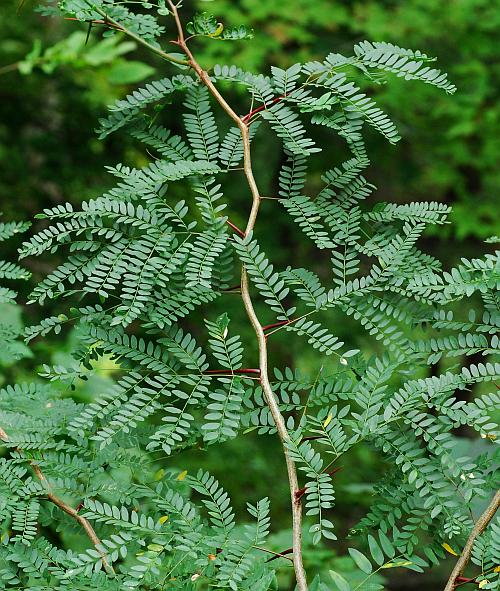Gleditsia aquatica Marshall
Water Locust

Native
CC = 10
CW = -5
MOC = 10
© SRTurner
Gleditsia aquatica MarshallWater Locust | |
 |
Native CC = 10 CW = -5 MOC = 10 |
© SRTurner |
|
Family - Fabaceae/Caesalpinioideae Habit - Tree, usually incompletely dioecious, often emergent aquatic. Stems - Trunks 10-20 m tall, the bark smooth, becoming finely grooved and occasionally somewhat scaly with age, dull gray to reddish brown, usually armed with conspicuous thorns, these 6-15 cm long, 2-6 mm in diameter at the base, often clustered, simple or few-branched. Branches differentiated into short shoots with clustered leaves and elongate shoots with alternate leaves, the twigs of long shoots often somewhat zigzag, the winter buds partially sunken and inconspicuous.
Leaves - Alternate, 1-2 times pinnately compound, appearing before flowers. Petiole 1-3 cm long. Petiole and rachis glabrous or nearly so. 1x compound leaves 12-15 cm long, with 7-10 pairs of leaflets, these 2-5 cm long, 0.5-1.5 cm wide, narrowly ovate, rounded to bluntly pointed at the tip, the surfaces glabrous, somewhat shiny. 2x compound leaves with 4-7 pairs of pinnae each with 7-9 pairs of leaflets, these 1.0-2.5 cm long, 0.5-1.2 cm wide, narrowly ovate to ovate, rounded to bluntly pointed at the tip, the surfaces glabrous, green to yellowish green, the upper surface shiny.
Inflorescences - spikelike racemes 5-15 cm long with many flowers, the pistillate inflorescence with fewer and more widely spaced flowers than the relatively dense staminate ones. Flower stalks 1-3 mm long. Sepals 2.5-3.0 mm long, 0.8-1.5 mm wide, finely hairy. Petals 2.5-3.0 mm long, 1.5-2.0 mm wide. Fruits - Legumes, relatively short, strongly flattened, the stalklike base 1-2 cm long, the body 3-5 cm long, asymmetrically elliptic or ovate, often twisted, glabrous, orange to reddish brown, lacking pulp. Seeds nearly circular, 10-12 mm long, 7-10 mm wide, brown.
Flowering - May - June. Habitat - Swamps, sloughs, bottomland forests. Origin - Native to the U.S. Lookalikes - Gleditsia triacanthos, Robinia pseudoacacia. Other info. - This swamp tree is found in Missouri's Bootheel, also ranging up the Mississippi River as far north as St. Louis. The continental U.S. range largely comprises a tight band moving southward through Louisiana, with more scattered populations along adjacent portions of the Gulf and Atlantic coasts. Photographs taken at Otter Slough Conservation Area, Stoddard County, MO, 10-18-2017, and at Mingo NWR, Stoddard County, MO, 9-10-2019 (SRTurner). |